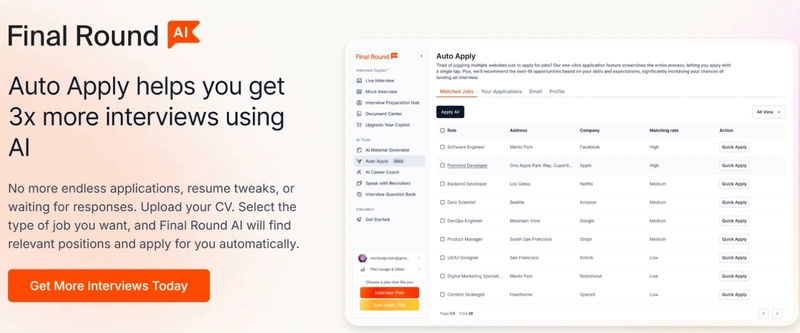Whether you're gearing up for your next big frontend role or just brushing up on your JS fundamentals, these 40 JavaScript interview questions will help you stand out and feel confident 💪🏻. From fundamentals to advanced quirks, it's all here.
Let’s dive in! 🔥
40 JavaScript Interview Questions With Smart Answers
1. ❓ What is JavaScript?
Understanding what JavaScript is at its core helps you build a solid foundation for everything else, whether it’s DOM manipulation, async programming, or frameworks like React or Vue. This is usually one of the first questions in any frontend interview.
Answer:
JavaScript is a high-level, interpreted, dynamic programming language primarily used to create interactive and dynamic content on websites. It runs in the browser (client-side), but it can also run on servers using environments like Node.js. JavaScript supports object-oriented, functional, and event-driven programming paradigms, making it a powerful tool for both frontend and backend development.
2. 🔁 What is the difference between var, let, and const?
Choosing the right keyword for declaring variables prevents bugs related to scoping, hoisting, and immutability. Interviewers ask this to assess how well you understand modern ES6+ JavaScript.
Answer:
-
var➡ Function scoped, hoisted and can be re-declared within the same scope. It was commonly used before ES6. -
let➡ Block scoped, not re-declarable within the same scope, and it’s hoisted but not initialized (TDZ - temporal dead zone). -
const➡ Block scoped, cannot be reassigned (immutable binding), though objects and arrays declared withconstcan still be mutated.
Use let and const for cleaner, more predictable code. const is generally preferred unless the value needs to change.
3. 🏷️ What are data types in JavaScript?
Knowing how data is represented and behaves in JavaScript helps prevent type-related bugs and improves debugging skills.
Answer:
JavaScript has two main categories of data types:
Primitive types (immutable, stored by value):
string,number,boolean,null,undefined,symbol,bigintNon-primitive types (mutable, stored by reference):
object,array,function
Understanding the difference between primitive and non-primitive types is crucial when working with assignments, comparisons, and memory management.
4. 🧮 What is the difference between == and ===?
This question tests your grasp of JavaScript’s type coercion system, which can often lead to subtle bugs if misunderstood.
Answer:
-
==➡ Performs type coercion before comparison (loose equality). Example:'5' == 5→true -
===➡ Compares both value and type (strict equality). Example:'5' === 5→false
Always use === to avoid unexpected behavior due to type coercion. It ensures cleaner and more predictable comparisons.
5. 📦 What is hoisting in JavaScript?
Hoisting is a fundamental concept that affects how variables and functions are accessed in different scopes. Interviewers use this to test your understanding of execution context.
Answer:
Hoisting is JavaScript’s default behavior of moving variable and function declarations to the top of their scope before code execution.
- Variables declared with
varare hoisted and initialized withundefined. -
letandconstare hoisted too, but they remain uninitialized in the Temporal Dead Zone (TDZ). - Function declarations are fully hoisted, meaning you can call them before their actual definition in the code.
Understanding hoisting helps prevent reference errors and improves code clarity.

Try Final Round AI for FREE today! 🔥
6. 🔐 What are closures in JavaScript?
Closures are a core concept in JavaScript and are heavily used in callbacks, currying, data privacy, and functional programming patterns.
Answer:
A closure is created when a function "remembers" the variables from its outer lexical scope even after that outer function has finished executing.
Example:
function outer() {
let counter = 0;
return function inner() {
counter++;
return counter;
};
}
const count = outer();
count(); // 1
count(); // 2
Here, inner still has access to counter, even after outer has run.
7. ⏲️ What's the difference between synchronous and asynchronous code?
JavaScript is single-threaded. Understanding async behavior is crucial for building performant web apps.
Answer:
- Synchronous code blocks further execution until it completes, it runs line by line.
-
Asynchronous code runs in the background (e.g., HTTP requests, timers), allowing the program to continue executing other tasks. It uses callbacks, Promises, or
async/awaitto handle execution flow.
8. ➡ What are arrow functions?
Arrow functions are concise and behave differently in terms of this. Great for functional-style programming.
Answer:
Arrow functions provide a shorthand syntax (() => {}) and don’t bind their own this, arguments, super, or new.target. This makes them ideal for short functions and callbacks but not suitable as methods or constructors.
9. 🗂️ What is lexical scope?
Understanding lexical scope helps you reason about variable visibility and how closures work.
Answer:
Lexical scope means that the scope of a variable is determined by its position in the source code. Inner functions have access to variables declared in outer scopes. It’s also the reason closures can access variables even after their parent function has returned.
10. 🌀 What is the event loop?
It's the heart of JS's async behavior. Knowing this will help you avoid race conditions and improve performance.
Answer:
The event loop manages the execution of multiple chunks of your program over time. It moves tasks between the call stack and the callback/task queue. It ensures non-blocking behavior by running tasks when the call stack is empty.
11. 🧰 How do you clone an object?
Copying objects is common, but you need to know when it's shallow vs deep to avoid reference bugs.
Answer:
-
Shallow copy:
Object.assign({}, obj)or{...obj} -
Deep copy:
JSON.parse(JSON.stringify(obj))(note: loses functions, dates, and special types) - Advanced: Use libraries like Lodash’s
cloneDeep()for deep cloning complex objects.
12. 🧾 What's the difference between map(), filter(), and reduce()?
These are fundamental tools in working with arrays and data transformations.
Answer:
-
map(): Transforms each item and returns a new array. -
filter(): Filters items based on a condition. -
reduce(): Accumulates values into a single result (e.g., sum, object merging).
13. 🕵🏻♂️ How do you check if a value is an array?
Arrays and objects are both of type "object", so you need a reliable method.
Answer:
Use Array.isArray(value) for an accurate check. Avoid using typeof, which returns "object" for arrays.
14. 💣 What is destructuring in JavaScript?
Destructuring makes your code cleaner and easier to read.
Answer:
Destructuring lets you unpack values from arrays or properties from objects into distinct variables.
const [a, b] = [1, 2];
const { name } = { name: "Alice" };
This simplifies data access from nested structures and APIs.
15. 🔗 What is the spread operator?
Spread is used in everything, cloning, merging, function calls, etc.
Answer:
The spread operator (...) allows you to expand elements of an iterable (like arrays or objects):
const arr = [1, 2];
const newArr = [...arr, 3]; // [1, 2, 3]
It’s useful for immutability patterns in React and merging data.
Try Final Round AI for FREE today! 🔥
16. 🧵 What are promises in JavaScript?
Promises are essential for managing asynchronous operations in a cleaner, more readable way than callbacks.
Answer:
A Promise represents the result of an async operation and has three states: pending, fulfilled, and rejected.
Instead of deeply nested callbacks (callback hell), promises use .then() and .catch() for chaining:
fetch('api/data')
.then(res => res.json())
.then(data => console.log(data))
.catch(err => console.error(err));
17. 💤 What is async/await?
async/await simplifies working with promises, making async code look and behave more like synchronous code.
Answer:
async functions return a promise, and await pauses execution until that promise resolves or rejects.
This makes code cleaner and easier to follow:
async function getData() {
try {
const res = await fetch('api/data');
const data = await res.json();
console.log(data);
} catch (error) {
console.error(error);
}
}
18. 📡 What's the use of fetch()?
fetch() is a modern standard for making network requests.
Answer:
fetch() is a browser API for making HTTP requests and returns a Promise. It's used for GET, POST, PUT, DELETE requests, and can be combined with async/await.
19. 🚨 How do you handle errors with async/await?
Async code is more error-prone. Graceful error handling is critical.
Answer:
Use try...catch blocks around await calls:
try {
const res = await fetch(url);
const data = await res.json();
} catch (err) {
console.error("Failed to fetch:", err);
}
This avoids unhandled promise rejections.
20. 🧪 What is Promise.all()?
It's a key technique for parallel async operations like multiple API calls.
Answer:
Promise.all() takes an array of Promises and resolves when all succeed, or rejects if any fail. Useful for parallel loading:
await Promise.all([fetchA(), fetchB(), fetchC()]);
21. 🧱 What are JavaScript modules?
Modules let you organize and reuse code across files.
Answer:
JS Modules use export to share code and import to consume it. They support encapsulation and are widely used in modern development (ES6+, React, Node.js, etc.).
22. 🕳️ What's the difference between null and undefined?
These are frequent sources of bugs and confusion.
Answer:
-
undefined: A variable that has been declared but not assigned. -
null: An explicit assignment indicating "no value".
Use null intentionally; avoid leaving values undefined.
23. 📈 Explain debounce and throttle.
These techniques optimize performance, especially in event-heavy UIs.
Answer:
- Debounce: Waits until a function hasn’t been called for X ms before running it (e.g., search input).
- Throttle: Ensures a function runs at most once per X ms (e.g., scroll events).
24. 🧷 What is the this keyword?
Misunderstanding this causes many bugs in object-oriented JS.
Answer:
this refers to the object that owns the current code. In methods, it refers to the parent object. In regular functions, this depends on the call context (or is undefined in strict mode). Arrow functions do not have their own this.
25. 🌳 What's prototypal inheritance?
It’s how JavaScript implements OOP, not with classes (until ES6), but prototypes.
Answer:
In prototypal inheritance, objects inherit properties from other objects via their prototype chain. It’s a flexible and dynamic alternative to classical inheritance.
26. 🧩 What is the DOM?
Frontend developers constantly manipulate the DOM to update the UI.
Answer:
The Document Object Model (DOM) is a tree-like structure representing a web page’s HTML elements. JavaScript can access and manipulate this structure dynamically.
27. 🕵️♂️ What's the difference between == and === in DOM comparison?
Comparing DOM elements can yield unexpected results if types mismatch.
Answer:
Same rule applies: use === for strict equality. When comparing DOM nodes, node1 === node2 checks if both refer to the exact same element.
28. 📚 How do you select elements in the DOM?
Selecting elements is the first step in any DOM manipulation.
Answer:
document.getElementById('id')document.querySelector('.class')document.querySelectorAll('div')
These methods help you target and modify elements dynamically.
29. 🖱️ What is event delegation?
It improves performance by attaching fewer event listeners.
Answer:
Event delegation uses bubbling to catch events higher up the DOM tree. For example, attach one click listener to a parent, rather than many to each child.
30. 🧼 How do you prevent default behavior in an event?
Preventing default behavior is often necessary for form handling or custom interactions.
Answer:
Call event.preventDefault() inside your event handler to stop default browser behavior (like form submission or link navigation).
31. 📜 What are template literals?
They make string formatting cleaner and more dynamic.
Answer:
Template literals use backticks and support interpolation:
const name = "Bob";
console.log(`Hello, ${name}!`);
They also support multi-line strings.
32. 📞 What is a callback function?
Callbacks are foundational to async JS, event handling, and array methods.
Answer:
A callback function is passed as an argument to another function and executed later. It enables things like event handlers and async logic.
33. ❌ What are the falsy values in JavaScript?
Conditional logic often depends on truthy/falsy checks.
Answer:
Falsy values are: false, 0, '' (empty string), null, undefined, NaN. All others are truthy. These influence conditions and short-circuit logic.
34. ⚖ Difference between typeof and instanceof?
Type checking helps with debugging and enforcing logic.
Answer:
-
typeof: Returns a string describing the type ('object','function','string', etc.). -
instanceof: Checks if an object inherits from a constructor’s prototype.
35. 🔥 What are immediately invoked function expressions (IIFE)?
Useful for avoiding polluting global scope and creating isolated code blocks.
Answer:
An IIFE runs immediately after it's defined:
(function() {
console.log("Runs immediately!");
})();
Great for modules and closures.
36. 🗃️ What's the difference between shallow and deep copy?
Copying data incorrectly leads to reference bugs.
Answer:
- Shallow copy: Copies top-level properties, references nested objects.
- Deep copy: Recursively copies everything. Required when you want full data isolation.
37. 🗑 How does garbage collection work in JavaScript?
Knowing memory management helps avoid leaks and performance issues.
Answer:
JS uses automatic garbage collection. When no references to an object remain, it becomes unreachable and is removed from memory by the GC.
38. 🌐 What is the difference between localStorage, sessionStorage, and cookies?
Knowing where and how to store client data securely and appropriately is a critical frontend skill.
Answer:
-
localStorage: persistent storage, up to 5MB, doesn’t expire. -
sessionStorage: temporary, cleared when the tab is closed. -
cookies: small (4KB), sent with every request, can be accessed by server.
localStorage.setItem("user", "Alice");
Use cookies for authentication, localStorage for preferences, and sessionStorage for temporary data.
39. 💭 What is a service worker?
It's the backbone of Progressive Web Apps (PWAs).
Answer:
A service worker is a JS script that runs in the background and enables offline access, push notifications, and background sync. It intercepts network requests and can cache assets for offline use.
40. 🧗🏻♂️ What are higher-order functions?
JavaScript is a functional language at heart. This concept underpins much of modern JS (like map, filter, etc.).
Answer:
A higher-order function is a function that takes another function as an argument or returns one.
function repeat(n, action) {
for (let i = 0; i < n; i++) {
action(i);
}
}
repeat(3, console.log); // Logs 0, 1, 2
It helps you write cleaner, reusable code, especially in functional-style programming.
🎉 Final Thoughts
Mastering these 40 JavaScript questions gives you a serious edge in frontend interviews 💡. They're not just about getting a job, they're about understanding how JavaScript really works. Use them to build cleaner code, solve harder problems, and impress interviewers.
Keep coding, stay curious, and interview like a boss! 🤵🏻
| Thanks for reading! 🙏🏻 Please follow Final Round AI for more 🧡 |
|---|









Top comments (37)
Nice list, but honestly after grinding so many of these questions, I still mess up the basics sometimes - you think doing tons of interview prep actually makes you better at the job or just better at passing interviews?
Totally feel you, you're definitely not alone in that. Messing up the basics even after lots of practice is more common than most people admit, and honestly, it just shows you're still actively learning and reflecting (which is a strength, not a weakness!).
As for prep vs. real job skills: I think intense interview prep sharpens specific muscles, like thinking aloud, recognizing patterns quickly, and handling pressure, which are super useful in interviews. But real job effectiveness often comes from solving messy, open-ended problems, collaborating with others, debugging in complex systems, and balancing trade-offs, things you usually don’t get in a coding interview.
That said, consistent prep does build habits like writing cleaner code, understanding fundamentals deeper, and learning how to explain your thinking, all of which carry over into the job. So while it might not mimic the day-to-day perfectly, it can still make you a more confident and competent developer overall.
Appreciate the honest comment. Keep at it, and don’t underestimate how far you've already come! 💪🏻🔥
This article was really practical and concise, especially for those who want to prepare for frontend interviews or need a quick review of JavaScript concepts.
Thanks for your clear explanations and helpful examples! 👏
If you know any additional resources for practicing or testing these questions online, I’d love to hear your suggestions.
Thank you so much for your kind words Mahdi! 🙏🏻 It truly means a lot to know the article was helpful and clear, that kind of feedback keeps me motivated to keep sharing. I’m really glad it served as a practical and concise review for you!
As for practicing and testing your JavaScript knowledge, here are some excellent resources I highly recommend:
Thanks 🙏
You're welcome 🙏🏻🙏🏻
Good list!
I'd go with structuredClone as an essential option for 11.
Thank you so much! 🙏🏻
Great catch,
structuredClone()is definitely a modern and safer alternative for deep cloning, especially since it handles complex data types more reliably thanJSON.parse(JSON.stringify()). It's also native and avoids the overhead of external libraries for many use cases.I’ll consider adding it to that section as a recommended option. Thanks for the excellent suggestion! 🔥
been grinding through lists just like this for ages lol - makes me wonder though, you think its more about knowing all these inside out or just showing you can think on your feet when stuff gets weird in interviews
I totally feel that, the grind is real! 😅
Honestly, it's a bit of both. Knowing these concepts inside out gives you a solid foundation, but what really sets candidates apart is being able to stay calm, reason things through, and adapt when the interviewer throws a curveball.
Interviews often test how you think, not just what you know. So even if you don’t recall every detail, showing that you can break down a problem, ask good questions, and think on your feet goes a long way. Glad the list resonated with you, you’re clearly putting in the work, and that mindset pays off!
Great list! These questions are super helpful for both interview prep and self-assessment. If you're a company looking to hire frontend developers, this is also a solid framework for evaluating real-world JS skills especially with concepts like closures, async/await, and the event loop. Thanks for putting this together!
Thank you so much! 🙏🏻
That means a lot, especially coming from someone clearly thinking about both sides of the table, prepping and hiring.
You’re absolutely right: concepts like closures, the event loop, and async/await don’t just show up in interviews, they reflect real-world understanding of how JavaScript actually runs in the browser. If a candidate can reason through those, it says a lot about their ability to debug and build reliable apps.
Really appreciate your thoughtful take and kind words, glad this list could offer value from multiple angles!
Thanks so much—I’m really glad the breakdown was helpful! 🙏🏻
Honestly, I’ve seen both approaches: some people dive deep into systematically drilling these questions, while others lean more on instinct and experience. That said, having a solid reference or structured guide (like the one you mentioned wishing for early on) can really make a difference. It helps turn “winging it” into delivering confident, well-informed answers.
Really appreciate you stopping by and sharing your thoughts—always great to hear from others who’ve been through the process!
Digital Dopamine
Thank you so much! 🙏🏻
Totally agree with you. Whether someone’s a seasoned dev or just starting out, having a clear and practical resource can really take the edge off the interview grind. It’s easy to overlook the fundamentals when we’re deep in frameworks and real-world projects, so revisiting core JS like this can be a game-changer, not just for interviews, but for writing better code overall.
I really appreciate your kind words and insight, comments like yours genuinely keep me motivated to create more content that’s helpful and grounded. 🙏🏻
so many of these trip me up way more than id like to admit - honestly, you think practicing a ton actually beats out just pure experience on the job?
Absolutely get where you're coming from, JavaScript can be deceptively tricky, and even experienced devs trip up on these sometimes. I really believe it's a mix: practice helps you recognize patterns and build confidence, but real-world experience teaches you how and when to apply them effectively.
In interviews, practice gives you clarity and speed. On the job, you get the kind of deep understanding that only comes from debugging real issues under real deadlines. Ideally, both feed into each other, practice sharpens your skills, and experience grounds them.
And, the fact that you're reflecting on this at all means you're already growing. 🚀
Nice!
Thank you so much! 🙏🏻
Perfect breakdown for interview prep, tbh I wish I had this kinda thing when I was starting out. You think most people actually drill these or just wing it and hope for the best?
Thanks so much. I’m really glad you found the breakdown helpful! 🙏🏻
Honestly, I’ve seen both: some folks go deep into drilling these questions, while others rely more on instinct and experience. But having a solid reference or structured guide (like the one you wished for starting out) definitely makes a difference, it helps turn “winging it” into confident, well-informed answers.
Appreciate you dropping by and sharing your thoughts, always great to hear from others who've been through the process! 🔥
Thanks 🙏👍
You're welcome 🙏🏻🙏🏻